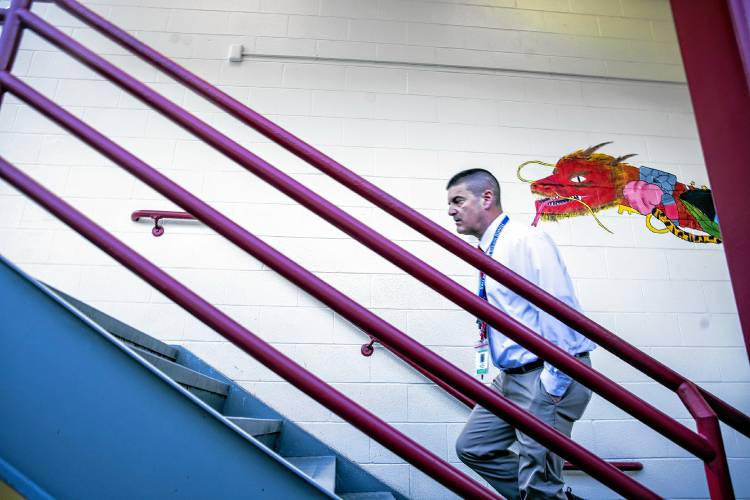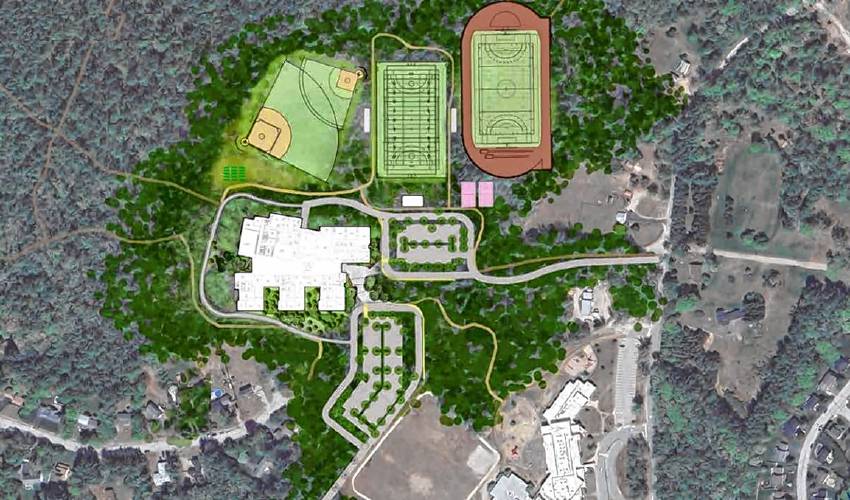Rethinking Rundlett: A divisive school decision in Concord echoes one from nearly 70 years ago
|
Published: 10-18-2024 2:12 PM
Modified: 10-19-2024 5:32 PM |
Concord’s school board planned to build a new junior high school and city residents wanted answers about the location.
An architect slammed the proposed property as “too remote,” questioning whether the parcel’s size, larger than others considered, “justifies the need for about three-quarters of the children of Concord to travel to the further-most end of town.” A location closer to downtown, he said, would be better.
The head of the school board published a sprawling explanation for the board’s evaluation and selection of its desired property.
The appeal was the expansiveness of the new site, its outdoor learning opportunities, its proximity to a fast-growing city neighborhood, and, primarily, its cost-efficiency.
“I am glad to restate these reasons,” it read. “It is important that every citizen have the facts about the site.”
To anyone who lives in Concord, this might sound familiar — but that was almost 70 years ago.
In 1955, the school district desperately needed to build a new school: it had no junior high, and those students were scattered across the city in three different schools. A rising glut of young Baby Boomers threatened to burst elementary schools at the seams. The solution was a 1,200-student junior high, and the district wanted to buy a 20-acre property off South Street to house it.
Fast forward to 2024.
Article continues after...
Yesterday's Most Read Articles
 New England College expands $10,000-per-year offer to Concord, Bishop Brady graduates
New England College expands $10,000-per-year offer to Concord, Bishop Brady graduates
 ‘There’s tradition up here’ – Morrill Farm approaches its centennial, celebrates evolution and growth
‘There’s tradition up here’ – Morrill Farm approaches its centennial, celebrates evolution and growth
 AROUND CONCORD: Your guide to free summer music
AROUND CONCORD: Your guide to free summer music
 ‘Life long friends’: Three women worked together to welcome visitors to East Concord
‘Life long friends’: Three women worked together to welcome visitors to East Concord
 New Hampshire home prices hit an all-time record high amid housing shortage
New Hampshire home prices hit an all-time record high amid housing shortage
 Truck collision on South Main Street in Concord diverts traffic
Truck collision on South Main Street in Concord diverts traffic
School leaders see the need for a new middle school as similarly dire — today’s students are stuck in an outdated building that is deteriorating around them. On hot days in June and September, portions of the building without air conditioning can hit 100 degrees.
The origin story for what is now Rundlett Middle School echoes the current debate to replace it, with one fundamental difference: Different rules governed the school board in 1955. In order for that project to move forward, two-thirds of voters in March elections had to approve the bond to purchase the land and build the new school.
By a decisive margin, they did. Nearly 80% of city voters backed the junior high project, and students took their seats in 1957. It carried a $1.4 million price tag — adjusted for inflation, that’s about $16 million in today's dollars. Times have changed.
Despite its modern-day autonomy, the Concord School Board is facing down a different, yet pivotal constituent vote.
Unlike its 1955 counterpart, members of the school board last year didn’t have to convince voters to back their choice when they chose a location for the new school. It may prove to be the project’s fatal flaw.
In the eleven months since the school board voted to move the middle school to raw land in East Concord, the planning process has chugged forward: the board appointed committees of construction experts, teachers and parents, refined the building features it wanted to include and set a budget for construction costs.
While Concord is almost a year closer to a new school, a group of citizens has successfully put two referendums on the ballot that could upend the location vote and delay the project. Board President Pamela Walsh, one of the new location’s most ardent backers, is up for re-election, facing a string of challengers pledging to reopen the middle school debate.
The two endeavors — that of the school district to deliver a new middle school at Broken Ground and that of citizens to force a rebuild at the current site — are now on an election-day collision course.
The city remains divided.
In the neighborhood closest to where the new middle school will go, “Rebuild at Rundlett” signs flourish on front lawns. The same is true in the South End, on streets near where the current school has stood since ‘57.
In recent weeks, a new set of signs have sprouted. Color-blocked green and blue, they urge residents to “Keep Concord Schools Strong” by voting “no” on the charter amendments.
For all the benefits of the Broken Ground site the school board has pointed to, many residents hold up one essential argument in the location debate: many constituents — especially in the neighborhoods most affected by this decision — want the school to stay where it is.
Liz Tardugno lives at the end of North Curtisville Road, near the cul-de-sac that holds the trailhead for the city’s Batchelder Mill Road trail network. She remains unswayed.
“I will be brief,” she said to the Concord School Board at a June project meeting, holding the microphone with one hand and her toddler on her hip with the other. “Because we’re not going to last.”
“I have friends downtown who bought property in the hopes that their children could walk to school, which now can’t,” she said. “And I now will have a school in my backyard which I don’t want.”
In the face of persistent pushback, current board members have spent the last year explaining, re-explaining and then explaining again why they chose Broken Ground. They have refined the design of the building itself while tripling the amount of land to be cleared from eight acres to 24 while insisting it will be more expensive to rebuild at Rundlett. The board has only grown more resolved in their choice — several members who had been pro-Rundlett said this summer that they’d changed their minds. Won over by their fellow board members, they feel that moving to Broken Ground is, “right for the taxpayers and for our kids.” They hoped those still partial to the current location would come around, but broad buy-in hasn’t materialized.
Some of the board’s justifications for a location change hold up to scrutiny. There isn’t room on South Street for features that students and residents have asked for; building a new school next to the current school would mean students and staff lose a lot of basic facilities for years on end. The outdoor learning opportunities at Broken Ground are more expansive.
Other arguments lack supporting information: the district was unable to provide any cost outlines for the project, including estimates for site work and infrastructure associated with a Broken Ground project, and leaders in the New American community said they felt left out of the decision-making process about the Broken Ground location before the school board claimed to advocate on their behalf.
Before voters go to the ballot box, Monitor reporting will analyze arguments on both sides of the location debate, seeking to answer the questions: Did the school board make the right decision to move the school to Broken Ground? And, if not, is going back on that decision the right path forward?
If the middle school project proceeds as planned, a ribbon-cutting at the new school would come in the summer of 2028.
For many inside Rundlett, that day can’t come fast enough.
Every time roof leaks leave brown stains on ceiling tiles, Principal Jay Richard is adamant that they be replaced. Three hundred new tiles have gone in since the end of the last school year.
“The stains, you know, it’s a pain for my custodian. But it really bothers me because I want it to look good for my kids,” Richard said. “These kids need to know that we care.”
Other signs of the school’s age are evident everywhere. On one side of the stairs, 65 years of foot traffic have worn divots down to the concrete.
In an eighth-grade art classroom, Stephanie Bednaz hangs a small tapestry over a hole in the wall — an old outlet that was removed but never refinished.
“I’ve worked here for 30 years, and I love Rundlett. But it’s a band-aid on a band-aid on a band-aid at this point,” She said. “It’s a hot disaster.”
Over the next week, a series of stories will examine the arguments in favor and against each location, answer frequently asked questions about the project and what it means for the city, and introduce findings from a district-wide survey conducted by reporters about both the project and the charter amendments. In tandem with this coverage, the Monitor is also hosting a forum on the evening of Oct. 2024 where, in addition to questions posed to candidates, a panel of Monitor reporters will discuss their work.















 Canterbury honors ‘real heroes’ with updated Military Veterans’ Project
Canterbury honors ‘real heroes’ with updated Military Veterans’ Project Look, up in the sky! It’s… an Airstream trailer?
Look, up in the sky! It’s… an Airstream trailer? Around Concord: Over The Moon Farmstead brings mead, beer, pizza and music to Pittsfield
Around Concord: Over The Moon Farmstead brings mead, beer, pizza and music to Pittsfield Around Concord: The Balshaws bring a rustic revival to the Canterbury Country Store
Around Concord: The Balshaws bring a rustic revival to the Canterbury Country Store
